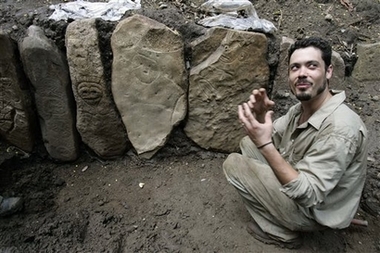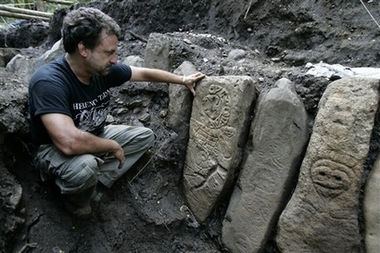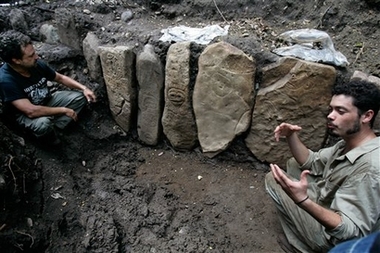LAND TIME FORGOT DEPT.
Major archaeological site found in Puerto Rico
Codex
by Don Jibaro
 SAN
JUAN, Puerto Rico - How do you lose something as big as a park in an island
that's barely 100x35 miles large? Well, you could cover it with malanga leaves
and put it where nobody will go for 500 years. ¡Caramba! ¡Smart Taino indians!
SAN
JUAN, Puerto Rico - How do you lose something as big as a park in an island
that's barely 100x35 miles large? Well, you could cover it with malanga leaves
and put it where nobody will go for 500 years. ¡Caramba! ¡Smart Taino indians!
And so... for hundreds of years all major world powers have conquered,
crushed, mastered, overpowered, overthrown,
ruined, subjugated, thwarted, trounced, undone and vanquished Indian
civilizations in the new world, then took home all spoils. Still, archeologists have finally found something
that conquerors did not take home with them. Something that time itself had forgotten...
until now.
Archaeologists say they have found the best-preserved pre-Columbian site in the
Caribbean, which could shed light on virtually every aspect of Indian life in
the region, from sacred rituals to shopping and eating habits; in others words, their very
personal lives.
They believe the site in southern Puerto Rico may have belonged to
the Taino or pre-Taino people that inhabited the island before European
colonization. The find contains stones etched
with ancient petroglyphs that form a large plaza measuring some 130 feet by 160
feet, which could have been used for ball games, jogging or ceremonial rites.
The petroglyphs include the carving of a human figure with masculine features
and frog legs (wow! that was some good cannabis, brotha'). Archaeologists also uncovered several graves with bodies buried
face-down with the legs bent at the knees — a style never seen before in the
region, although popular to ancient times in Africa and the Middle East. It's
called the space saver sepulchre.
The plaza may or may not contain other artifacts dating from 600 A.D. to 1500 A.D.,
including piles of refuse from daily life, ergo... trash! Fossilized trash!
"I have visited many sites and have never seen a plaza of that magnitude and of
those dimensions and with such elaborate petroglyphs," said Miguel Rodriguez,
member of the government's archaeological council and director of a graduate
school in Puerto Rico that specializes in history and humanities.

Giddy
USA archaeologist
Nathan Mountjoy sits next stones etched with ancient petroglyphs and graves that
reveal unusual burial methods in Ponce, Puerto Rico. The archaeological find,
one of the best-preserved pre-Columbian sites found in the Caribbean, form a
large plaza measuring some 130 feet by 160 feet (40 meters by 50 meters) that
could have been used for ball games, jogging or ceremonial rites. (AP Photo/Andres
Leighton)
Archeologists have suspected since 1985 that the area contained
indigenous artifacts. But their extent and significance only became clear this
month when the U.S. Army Corps of Engineers began work on removing them so the
land could be used for a dam project, not some damn project.
Experts called for a HALT! ...to the excavation, saying the use of heavy
machinery exposed the stones to the elements and may have already destroyed
important artifacts. The horror!!! The Corps of Engineers said to fear not, that
the site will be preserved. (read second story below)
As we all well know by now, the Tainos were a subgroup of the Arawak Indians,
who migrated to the Caribbean island looking for an easier life and escape the
fierce Carib cannibals from the south, South America, that is... centuries before
European colonizers arrived to take their gold and write history. Tainos also carved
rocks and napped in hammocks.

Puerto Rican archaeologist Hernan Bustelo sits next
stones etched with ancient petroglyphs and graves that reveal unusual burial
methods in Ponce, Puerto Rico, Tuesday, Oct. 23, 2007.
Only a few of them archeologists were convinced that a competent
investigation of that site will offer a rare perspective on pre-Columbian and
pre-colonial history. How rare the perspective might be,
was not declared. He fears that the diggers are not equipped to handle such a
massive and complex job.
The USA consulting firm leading the excavation said that a back hoe, yes... a
hoe, that scrapes inches (centimeters) at a time did break some bones, oh oh!
...but that the same would have occurred through manual excavation. Yeah, right!

Again, U.S. archaeologist Nathan Mountjoy, right, and his Puerto Rican colleague Hernan, show the stones with petroglyphs found in a mountainous area where the
U.S. Army Corps of Engineers is working to build a dam in Ponce. The archaeological site, that could represent an entire
Taino indigenous village called 'Batey', might end up under water if the dam
project is not stopped. (AP Photo/Andres Leighton)
The company switched to slower and more detailed excavation methods about two
weeks ago, after the site's significance became clear. Yes, it was a real
bona-fide ancient site, so they immediately rushed home to fetch the Carbon-14
Dating Spectroscopes.
The discovery will presumably provide more data than the bits of Pre-Columbian relevance we
already have, thanks to the Inquisitional Spaniards who burned the "heathen"
codices (a quire of manuscript pages held together by stitching: the earliest
form of book, replacing the scrolls, stone and wax tablets of earlier times)
in which they Indian history was customary recorded.
There you have it, mi gente... take away a man's notebook, and he will carve in
stone!
How did you see it?

Klepto Flakes Dept.
Puerto Rican archaeologists accuse U.S. Army Corps of taking artifacts
without permission
 SAN JUAN, Puerto Rico: Puerto Rican archaeologists on Monday accused the U.S.
Army Corps of Engineers of illegally shipping two dozen newly discovered
pre-olumbian artifacts off the island without permission.
SAN JUAN, Puerto Rico: Puerto Rican archaeologists on Monday accused the U.S.
Army Corps of Engineers of illegally shipping two dozen newly discovered
pre-olumbian artifacts off the island without permission.
Diana Lopez, a University of Puerto Rico archaeologist, said the Army Corps
should be fined for sending ceramic pieces, stone tools and bones — which may
date from 600 A.D. to 1500 A.D. — to Atlanta for testing without approval from a
local archaeology council.
"They never told us that they were going to take those pieces," said Miguel
Rodriguez, a member of the council who claimed such tests could have been done
on the island.
Jose Rosado, chief of the corps' San Juan construction office, has promised that
engineers will return the pieces to Puerto Rico once tests determine their
origin and value. Calls and e-mails to his office went unanswered Monday.
The artifacts were discovered earlier this month when an Army Corps team began
work on a dam project in southern Puerto Rico. Archaeologists said the find
could shed light on most aspects of Indian life in the region, from sacred
rituals to... well, you know the story.
Peace and Prosperity,
Don Jíbaro



“Live in such a way that no one blames the rest of us
nor finds fault with our work.” --(2 Corinthians 6:3)

Don Jíbaro







